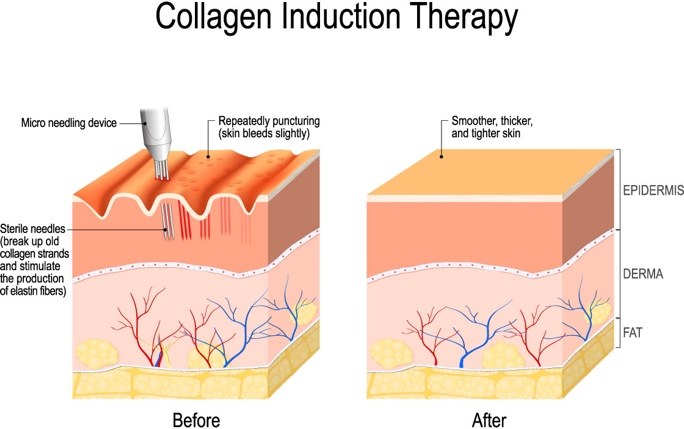What Is Microneedling/Skin needling?
Microneedling is, in our opinion, one of the most effective treatments out there that can effectively treat a multitude of skin concerns.
Microneedling or Skin-needling is also known as ‘collagen induction therapy’, which means that it encourages the production of collagen. Microneedling uses microscopic, oscillating needles to create hundreds of tiny, invisible punctures to the skin. This is known as a controlled trauma that stimulates the skin’s natural healing processes and can lead to both increased collagen and elastin production as a result of stimulation of the TGF beta1 (growth factor).

What can Microneedling do for you?
Skin needling with a microneedling device aims to give you more youthful-looking skin by stimulating collagen production.
Microneedling is used as a treatment for those looking to reduce signs of ageing in their skin and those looking to improve the appearance of pores. It helps to lessen the appearance of acne scarring, improve skin elasticity and diminish the appearance of wrinkle depth as it allows the skin to regenerate itself.
- Adjustable needles for targeting skin of different textures, thicknesses and skin concerns.
- Can be used on all parts of the body, including the face, neck, stomach, back, hands etc.
- Increases the skin’s ability to absorb anti-aging serums and topical creams.
- Helps to fade sun damage and hyperpigmentation.
- Useful in treating stretch marks
- Can be used in cosmetic nursing in conjunction with dermal fillers or surgical procedure.
- Minimal discomfort and downtime.
What is the Microneelding process?
Microneedling is a unit within our cosmetic dermal science qualifications and included in our Dermal Therapy courses and our cosmetic nurse training. You can visit aacds student clinic at aspire training clinics to make a booking. The process begins with you filling out a medical questionnaire surrounding the contraindications and implications of microneedling. Then the skin is cleansed and prepared by your Dermal therapist or cosmetic nurse. Once this is completed, your skin will be numbed with a topical cream that may take approximately thirty minutes.
Once your practitioner removes this cream, the needling can begin! The needling process is the use of a microneedling device on the skin to create tiny pin-prick wounds to the surface of the skin in a specific pattern. The skin may bleed a small amount. In our opinion, some blood is important - blood shows that growth factors have been triggered, and there is research for and against bleeding when you’re being needled, but erythema (redness) is a must to ensure that you have microneedled correctly. The session can take up to one hour, but could be as short as twenty minutes, depending on whether you’re having it carried out on a localised area or in more places.
Would we describe the sensation as pain? No , however there can be a slight discomfort, particularly in areas where the skin is thinner, such as the under-eye area or the nose.
After the procedure, your skin will be a bit red and inflamed for a day or two, but there is no significant downtime. When it comes to aftercare, you really need to be careful not to allow bacteria to get near you for the first 24 - 48 hours, because the microchannels are essentially wounds. On top of that, you shouldn’t apply any skincare in that 48 hour period except Hyaluronic acid or a vitamin B. Even chemical SPF, so it is recommended that you stay away from any sunlight if you can, especially when your skin will be light-sensitive in this time and use zinc based SPF when exposed to the environment.
How Long Does It Take To See Effects?
Microneedling works by triggering what we call the healing cascade, which is when the body senses inflammation and sends growth factors to the area and ups the production of collagen and elastin by affecting the structure of the skin. These proteins and growth factors will plump up the skin and make it appear smoother. Another effect will be increased skin cell turnover, for brighter, smoother, newer skin. You may start to see effects as soon as two weeks afterwards and the effects can be permanent. Usually, after a course of microneedling, you’ll see the optimum results for up to 12 months.
Who Should not have Microneedling?
- Pregnant women due to the topical anaesthetic.
- Those suffering from psoriasis or other skin conditions.
- Those taking isotretinoin (RoAccutane, Accutane)
- Those who have MS, diabetes or other conditions that impair healing or could be affected by the sensory effect of the numbing.
- Those with keloid scarring cannot have microneedling, keloid scars treated due to the synthesis of collagen which may make keloids worse.
- Those with open wounds or infections (ie. acne, cold sores, contact dermatitis) as it will spread bacteria or the virus across your face, but microneedling is fantastic for scarring once these have healed fully.
Ready to book your appointment?
If you would like to book a microneedling session, you can choose between having your treatment done by the students studying dermal science and cosmetic nursing (at a much more cost-effective price) or by one of the Aspire Trainers (at the full price). Please click HERE to book your appointment.

 WHEN YOU SPEND OVER $150(Afterpay not offered on cosmetic nurse treatments)
WHEN YOU SPEND OVER $150(Afterpay not offered on cosmetic nurse treatments)
 WHEN YOU SPEND OVER $150(Afterpay not offered on cosmetic nurse treatments)
WHEN YOU SPEND OVER $150(Afterpay not offered on cosmetic nurse treatments)

